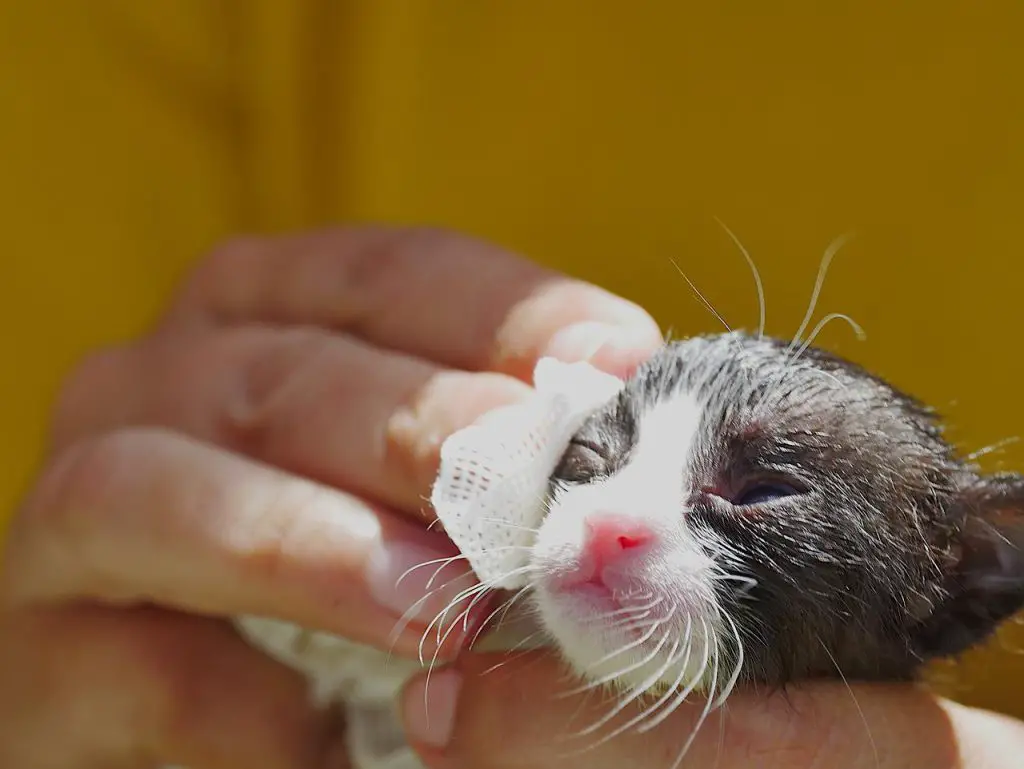If you have kittens under 8 weeks of age, it is important to treat them for fleas. Kittens that young are more susceptible to the negative effects of flea treatments, so using a product specifically designed for their age is crucial.
In this blog post, we will discuss how to treat kittens under 8 weeks of age for fleas and keep them healthy and happy!
Key Takeaway
- Fleas in kittens are tiny external parasites that feed on the blood of their host, causing discomfort, and itchiness, and potentially leading to more serious health issues such as anemia.
- Treating fleas on kittens under 8 weeks of age can be safely done by using a flea comb once or twice a day, giving them a gentle bath with dish soap, and ensuring their environment is free of fleas.
- The risks of fleas on kittens include causing severe discomfort and itching, leading to anemia due to significant blood loss, transmitting other parasites such as tapeworms, and potentially resulting in life-threatening conditions.
What Are Fleas In Kittens
Fleas are small, dark brown insects that live off the blood of warm-blooded animals. They are wingless and have a hard, flat body that is well adapted for moving through fur or feathers.
Fleas are excellent jumpers and can leap up to 200 times their own body length. This makes them very difficult to catch and makes them good at spreading from one host animal to another.
There are over 2000 species of flea but the most common in North America is the cat flea, which will happily bite humans as well as cats and dogs.
Fleas can cause a lot of discomfort to their hosts as they bite and feed. They can also transmit diseases like typhus and tapeworms. In severe cases, fleas can cause anemia in young animals.
Fleas in kittens are a common problem and can cause a lot of distress to both the kitten and its owner. The good news is that there are many effective treatments available to get rid of fleas in kittens.
Fleas are difficult to control once they get established in an environment. The best way to prevent them is to keep your pets free of them and to vacuum regularly. If you do find yourself with a flea infestation, there are a number of products available to help get rid of them.
There are a few things you can do to try and avoid getting fleas in the first place. One is to make sure your pet is on a regular deworming schedule prescribed by your veterinarian.
Another is to use tick and flea preventatives on your pet year-round, even if they live mostly indoors. And finally, vacuum regularly and wash your pet’s bedding often.
How To Treat Fleas on Kittens Under 8 Weeks of Age

To treat fleas on kittens under 8 weeks of age, it’s recommended to use a flea comb dipped in hot soapy water for gentle combing, give them a careful bath with dish soap to kill live fleas, and ensure all their bedding, toys, and surrounding areas are thoroughly cleaned
According to the American Society for the Prevention of Cruelty to Animals (ASPCA), most commercial flea treatments should not be used on kittens younger than 12 weeks old.
Some products may be labeled as safe for use on kittens as young as eight weeks, but it’s always best to err on the side of caution and wait until your kitten is at least 12 weeks old before using any type of flea treatment product.
The best way to treat fleas on kittens under 8 weeks of age is without using any products, only a flea comb.
If your kitten is old enough to be combed, you can use a flea comb to remove fleas. First, wet the kitten’s fur with warm water to make the fleas easier to remove. Then, using a fine-toothed Flea Comb, start at the head and work your way down the body.
Make sure to comb through all of the fur, paying special attention to areas where fleas are most likely to congregate, such as around the neck and tail. Every few strokes, dip the comb in a cup of warm water to drown the fleas. Finally, give your kitten a thorough bath with flea shampoo to remove any remaining fleas or eggs.
Flea combs are an effective way to remove fleas from your kitten, but they can be time-consuming. If you’re looking for a quicker solution, there are many different types of flea products available that can kill fleas on contact. Be sure to choose a product that is specifically designed for use on kittens, as some products can be too harsh for their delicate skin.
Can You Put Flea Medicine On a 7-week-old Kitten?

Flea medication should not be used on kittens under 8 weeks of age, instead, it’s recommended to physically remove fleas with a flea comb, give them a careful bath, and ensure their surroundings are thoroughly cleaned.
There are a few things you can do to get rid of fleas on a 7-week-old kitten. The first thing you should do is take your kitten to the vet to get checked out and make sure there are no other health problems. If your kitten has fleas, you should also ask the vet about using a Flea comb on your kitten.
This can help remove fleas and their eggs from your kitten’s fur. Finally, make sure to vacuum your house regularly and wash all of your bedding in hot water to help prevent fleas from coming back.
There are many different types of flea medicine available for kittens. Some of the most popular brands include Frontline, Advantage, and Revolution.
These products usually come in topical form, which means they are applied directly to the skin. However, they are not for kittens younger than 12 weeks.
Frontline is one of the most popular brands of flea medicine available. It is a topical medication that is applied directly to the skin. The advantage is another popular brand that offers both topical and oral options.
Revolution is a newer brand that offers a broad-spectrum approach to Flea and Tick control. There are many other options available, so be sure to speak with your veterinarian about which one is best for your kitten says PetMD.
At What Age Can You Use Flea Treatment on Kittens?

The general rule of thumb is that kittens should be at least eight weeks old before using any kind of topical flea treatment. This is because their skin isn’t fully developed yet and they could have a reaction to the chemicals in the treatment. If you’re not sure whether your kitten is old enough, it’s always best to check with your veterinarian first.
Once you’ve determined that your kitten is old enough to use flea treatment, the next step is to choose the right product. There are a lot of different options on the market, so it’s important to do some research before making a decision.
You’ll want to consider things like safety, effectiveness, and ease of use. Once you’ve found a product that you’re happy with, be sure to follow the instructions carefully to avoid any potential problems.
There are a few things to keep in mind when choosing a flea medicine for your kitten. The most important factor is to choose a product that is safe for kittens. Many products on the market contain chemicals that can be harmful to kittens if not used correctly. Be sure to read all labels carefully and follow the instructions before using any flea product on your kitten.
Another important factor to consider is how effective the product is at killing fleas. Some products may only kill adult fleas, while others may also kill larva and eggs. This is important to consider if you have an infestation as you will want a product that can eliminate all stages of the flea life cycle.
Finally, you will also want to consider how easy the product is to use. Some products come in topical formulations that are easy to apply, while others come in oral tablets or capsules.
How Do You Get Rid of Fleas on Kittens Naturally?
There are many natural flea remedies out there, but not all of them are effective. Some may even be harmful to your pet. Before trying any natural flea remedy, be sure to do your research and consult with your veterinarian.
1. Make a flea collar
One option is to make a flea collar. You can do this by soaking a bandana in a mixture of water and apple cider vinegar. Then, put it around your pet’s neck and let it dry. The vinegar will help to repel the fleas.
Apple cider vinegar is acidic, and fleas don’t like acidic environments. Apple cider vinegar also masks the smell of your dog, making it less attractive to fleas. You can use apple cider vinegar as a Flea collar by putting some in a spray bottle and spraying it on your dog’s neck and back.
Be sure to avoid the eyes, nose, and mouth areas. You can also add some apple cider vinegar to your dog’s food or water bowl. Check with your veterinarian before adding apple cider vinegar to your pet’s diet. Some pets are allergic to apple cider vinegar.
2. Use diatomaceous earth
Diatomaceous earth is a safe, natural way to get rid of fleas in your home. You can sprinkle it around your house (be careful not to get it wet or it will lose its effectiveness). You can also put it on your pet’s bedding or in their favorite sleeping spot. Just make sure to vacuum regularly to remove the dead fleas and eggs.
Apply the diatomaceous earth directly to your pet’s fur. It works by dehydrating the fleas, and eventually causing them to die. Be sure to reapply diatomaceous earth every few days, as it will lose its effectiveness over time.
First, the diatomaceous earth is very sharp. The tiny particles cut through the fleas’ exoskeletons, which causes them to dehydrate and die. Second, diatomaceous earth is absorbent. It absorbs the oils and fats from the fleas’ bodies, which also leads to dehydration and death.
Finally, diatomaceous earth creates an unfavorable environment for fleas. The dust irritates their respiratory systems and they can’t lay their eggs in it.
3. Use a flea comb
Flea combs are one of the most popular and effective ways to remove fleas from your pet. Flea combs work by physically removing the fleas from your pet’s fur.
The comb will catch the fleas in its teeth and pull them out of the fur. This process can be repeated multiple times until all the fleas have been removed. Flea combs are safe to use on all types of pets, including dogs, cats, rabbits, and guinea pigs.
There are a few things to keep in mind when using a flea comb on your pet. First, make sure that you comb through all of your pet’s fur so that you don’t miss any fleas. Second, be careful not to pull too hard on the fur, as this can cause pain or discomfort to your pet. Finally, after you have finished combing, make sure to inspect the comb for any fleas that may have been missed.
If your kitten has fleas, you may be able to comb them out with a fine-toothed flea comb. Start at the head of your pet and work your way down, being careful not to miss any spots. Dip the comb in soapy water after each stroke to kill the fleas.
You may also need to give your pet a bath with flea shampoo to get rid of all the fleas. Be sure to follow the directions on the shampoo bottle. If you’re still seeing fleas after treatment, contact your veterinarian for help.
The Risks of Fleas on Kittens
Fleas on kittens pose a serious risk as they can cause discomfort, lead to severe anemia due to blood loss, transmit other parasites like tapeworms, and potentially result in fatal conditions.
Itching and Discomfort
Fleas are notorious for causing intense itching and discomfort in kittens. The incessant scratching can lead to open wounds that are susceptible to infections, adding another layer of health concerns for the young feline.
Anemia Due to Blood Loss
Kittens, due to their small size, are at high risk of developing flea anemia. This condition arises from the loss of blood due to fleas feeding on them. Symptoms of anemia include weakness, lethargy, and rapid breathing. If left untreated, it can lead to death.
Transmission of Other Parasites
Fleas are not just a nuisance but also carriers of other parasites such as tapeworms. A kitten infested with fleas is at risk of contracting these additional parasites, complicating their health condition further.
Potentially Fatal Conditions
Severe flea infestations can be life-threatening for kittens. Diseases and conditions such as Feline Homotrophic Mycoplasmosis (FHM) and plague can be caused by fleas, posing a significant threat to the kitten’s life.
Even the flea saliva can cause skin inflammation, scabbing, and hair loss in cats, which can lead to serious health issues.
Does Pet Insurance Cover The Cost of Kitten Flea Treatment?
Whether pet insurance covers the cost of kitten flea treatment largely depends on the specific policy, as some policies may cover preventive care, which could include flea treatments, while others might not.
Pet insurance policies vary greatly in their coverage. Some insurers offer wellness plans or preventive care add-ons that may cover routine care expenses such as vaccinations, annual check-ups, and potentially flea treatments.
These are usually provided in addition to the standard insurance policy, which primarily covers unexpected illnesses or accidents.
However, many standard pet insurance policies do not cover routine or preventive care, which includes flea treatments. They are typically designed to help with the cost of unexpected veterinary care, such as surgeries or treatments for illnesses.
FAQs
Q: How can I get rid of fleas on kittens?
A: To get rid of fleas on kittens, it is best to consult with a veterinarian. They will be able to recommend safe and effective flea treatments that are suitable for young kittens.
Q: Can I use a flea comb to treat fleas on kittens?
A: Yes, you can use a flea comb to remove fleas and flea dirt from kittens. However, this method may not be as effective as using a flea treatment recommended by a veterinarian.
Q: Is it safe to bathe kittens to treat fleas?
A: It is generally not recommended to bathe kittens to treat fleas, especially if they are under 8 weeks old. Bathing may not effectively eliminate the fleas, and there is a risk of the young kittens getting chilled.
Q: Can I use a flea collar on kittens under 8 weeks of age?
A: Most flea collars are not safe for kittens under 8 weeks of age. It is best to consult with a veterinarian for safe and effective flea control options for young kittens.
Q: Can I use a topical flea treatment on kittens?
A: Some topical flea treatments may be safe for kittens, but it is important to follow the instructions and use a product that is specifically labeled for use on kittens. It is always best to consult with a veterinarian before using any flea treatment on kittens.
Q: Are there any flea treatments that are safe for kittens as young as 4 weeks old?
A: There are some flea treatments that are labeled as safe for use on kittens as young as 4 weeks old. However, it is still recommended to consult with a veterinarian to ensure the safety and effectiveness of the flea treatment for such young kittens.
Q: How can I prevent fleas on newborn kittens?
A: To prevent fleas on newborn kittens, it is important to keep the mother cat and the environment clean and free from fleas. Regularly clean and wash bedding, vacuum the area, and consult with a veterinarian for safe and appropriate flea prevention methods for the mother cat.
Q: Can older kittens get fleas?
A: Yes, older kittens can get fleas. It is important to regularly check for fleas and take necessary preventive measures to keep your kittens flea-free.
Q: What should I do if my kitten has fleas?
A: If your kitten has fleas, it is best to consult with a veterinarian for appropriate flea treatment options. They will be able to recommend safe and effective products or methods to remove the fleas and prevent reinfestation.
Conclusion and final thoughts
Overall, fleas can cause significant health risks for kittens if not treated properly. It is important to take preventive and proactive steps to protect young kittens from fleas.
First and foremost, all cats should be kept up-to-date on their vaccinations, especially when they are still very young.
Keeping the environment clean and free of debris or other materials that may attract fleas can also help to minimize the risks.




